The Spring 2011 Anime Preview Guide
Carlo Santos
by Carlo Santos,
Born in a hospital named after a famous dead person, Carlo discovered his obsessive-compulsive powers at an early age and began to consume art, culture and technology at an alarming rate. This led to his current 6-year stint with Anime News Network where he contributes reviews, writes the Right Turn Only!! manga column and can sometimes be seen prowling convention halls with a camera in his hand and a violin case on his back. Heaven help those who have to be subjected to either of them.

Blue Exorcist
Rating: 3 (of 5)
Review:
At long last, Blue Exorcist arrives on its loud, thunderous hype train, following the teasers during airings of Madoka Magica, a Viz manga tie-in for English-speaking readers, and web streams on every anime site imaginable. But the hype train, it turns out, hasn't developed a full head of steam just yet.
Keeping in line with the manga's long, almost-100-page exposition, the anime begins on a slow burn, dwelling upon the characters and the world they live in before digging into the action. Episode 1 introduces teenage troublemaker Rin Okumura, who along with his brother Yukio lives in the care of local pastor Father Fujimoto. Apparently, Rin's Christian upbringing hasn't stopped him from getting into fights, but when he earns himself a part-time job, things finally start looking up. The episode wastes too much time making a big deal out of Rin's new supermarket gig, but the point of it becomes clear when he tries to help a little girl, causes a ruckus, and accidentally starts seeing spirits. That's where things start getting interesting, and this episode's last several minutes provide the payoff: demonic transformations, auras of blue flame, Biblical incantations, and a Satanic revelation that tops them all.
The episode's thrilling finish is bolstered by top-of-the-line animation: tiny little spirits in constant motion, melee combat framed by intense, in-your-face angles, and special effects that blend seamlessly into the visuals. The same can't be said for the scenes in the middle, though, which appear to have been farmed out to studios that specialize in dull slice-of-life material. (And who can blame them? That's pretty much what Rin's supermarket job is.) But those snippets of daily life, boring as they may be, serve a purpose as story-building moments where we get to know the characters and start developing sympathy for them.
Overall, this show succeeds on the merits of its polished (if slightly bland) action-adventure style. It's sure to get fans fired up—although they'll have to wait a bit for the series to fire itself up first.
Blue Exorcist is available streaming on Crunchyroll, Hulu, VizAnime.com and ANN.

The World God Only Knows Season 2 Episode 2
Rating: 5 (of 5)
Review:
There may have been some doubts about the hackneyed premise that began the second season of The World God Only Knows—tough martial arts girl secretly likes cute things!—but with Episode 2, all those doubts are swept away. The excellent conclusion to the Kusunoki Kasuga arc sees our hard-nosed heroine going on the World's Most Awkward Date with smug, game-obsessed protagonist Keima Katsuragi. Granted, this charade is simply an attempt to make Kusunoki confront her "weak" side and force out the "loose soul" that's bothering her, but the laughs just keep coming: Keima's unabashed selfishness at the game store, an overly physical round of whack-a-mole (or rather, lobster), even a hilariously uncomfortable moment in the purikura booth. The genius is in seeing all these dating-sim clichés subverted by two completely unwilling participants.
And that's just the halfway point. The real payoff comes when our uneasy couple engages in the ultimate display of sentimental romantic goop—a shared ice cream cone—and the loose soul pops out to battle Kusunoki, switching from comedy spoof to pure action in seconds. Then comes the emotional punch: Keima, Elsie and Kusunoki launch into a passionate, thoughtful discussion about how to accept different sides of one's personality—and finally resolve it in a heartfelt way only this series can pull off so well.
Between the great genre send-up, the slickly animated hand-to-hand combat, and a heartwarming turnabout in the final act, this episode shows incredible storytelling range. And that's not including all the little things it does right: Elsie's background sight gags, color schemes that shift to match the mood, rich background music that walks a careful line between spoof and seriousness. It doesn't even have to throw around otaku in-jokes at this point—instead it relies charming characters, pitch-perfect comedy, and a lot of heart to tell its story. A story that'll be well worth watching, all the way to the end.
The World God Only Knows Season 2 is available streaming on Crunchyroll.
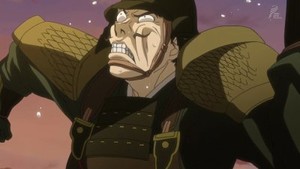
Hyouge Mono
Rating: 2.5 (of 5)
Review:
Something about Hyouge Mono just doesn't sit right. Sure, it's beautifully produced, with rich period visuals looking like Gekiga Gone Technicolor and a jazz-fusion soundtrack that recalls the historical-meets-hip-hop stylings of Samurai Champloo. But you know how sometimes, lots of individually outstanding elements fail to come together as a whole? Kind of like the 2011 Boston Red Sox? This is the anime equivalent—a 16th-century oddity that tries to be a character-driven drama ... or possibly a deadpan comedy ... or maybe a political sword-slasher ... well, perhaps you'll figure it out from the description?
The star of the show is Sasuke Furata, a field messenger in the service of famous warlord Oda Nobunaga. Sasuke also has an appraiser's eye for valuable objects, so it falls on him to inform a rival warlord, Matsunaga, that Nobunaga is interested in striking a deal for a legendary teakettle called the Hiragumo. (See, this is the part where it seem to be veering into comedy ... unless it's not.) Matsunaga, too proud to make such a concession, instead makes a big show of strapping the teakettle to his body and detonating himself. Sasuke—who in another universe might be a presenter on Antiques Roadshow—is understandably shocked and tries to retrieve the fragments of the teakettle, but Nobunaga brushes it off and seems content with the results. Perhaps, as one of the court officials suggests, it was simply Nobunaga's way of testing Matsunaga, who was once a friend but then betrayed him? There's your character drama right there, except that it's in the context of haggling over a piece of kitchenware, which just seems odd.
The episode closes with Nobunaga asking Sasuke to appraise a ship that has just pulled into the harbor—suggesting that the series might play out like a documentary about famous feudal-era artifacts. But it's hampered by a plodding pace, with lots of stiff, straight-ahead camera views and meandering conversations. It's still gorgeous to look at (and to listen to), but the execution just gives it a weird, dusty history-textbook smell.

Deadman Wonderland
Rating: 4 (of 5)
Review:
Not as obtuse as Steins;Gate, and not as self-conscious as Tiger and Bunny, Deadman Wonderland looks to be the textbook example of action-thriller anime this season. Its story is laid out thus: high-schooler Ganta Igarashi is chatting with his friends one morning about their upcoming field trip, an excursion to the privately funded prison-cum-theme-park Deadman Wonderland. However, Ganta's school life is shattered when a mysteriously cloaked "Red Man" descends in front of the classroom window and causes a massive explosion. The next thing Ganta remembers is waking up to find all his classmates dead ... and lawyers accusing him of doing the deed. For such a heinous crime, there is only one appropriate punishment: Ganta will be making the trip to Deadman Wonderland after all. As a prisoner on death row.
The premise of the series hits all the right buttons as far as provocative sci-fi is concerned: a dystopian future where a shiny facade hides a dark underbelly, where the rich and powerful run the show while treading on the backs of the underprivileged, and where morally questionable social experiments are the order of the day. But those elements alone would just make it a preachy parable—the real twist is that Ganta, after transferring to the prison, discovers a strange telekinetic power shooting out of his bloodied palms. Yet even that may not be as strange as the other teenaged inmate he meets: a white-haired, white-clad girl called Shiro who insists on being Ganta's friend.
A high level of animated polish gives this series its futuristic gleam, from the projection-video smartphones to the eerie Disneyland-built-atop-Chernobyl aesthetic of the prison. Attention to detail is evident not only in the wide range of character designs, which run the gamut from youth to middle age, but also in the shadowy, metallic walls of the prison grounds. Dissonant chords and fragments of sound in the background also add to the uneasy mood, creating a perfect nightmare world for the series' freaked-out protagonist. You say anime's gotten too wimpy these last several years? Deadman Wonderland says you're wrong.
Deadman Wonderland is available streaming on Crunchyroll.

We, Without Wings – Ore-tachi ni Tsubasa wa Nai Episode 2
Rating: 0.5 (of 5)
Review:
Maybe someday, history will see We, Without Wings as an anime ahead of its time. Maybe someday it will be recognized as an early example of "bro anime," a post-moe phenomenon where instead of sissy boys blubbering about which girl they like, we have hearty, virile men letting their libidos run wild.
Or maybe this is just an awful, misogynistic mess where the guys are incredibly awkward even by anime standards, openly approaching women to ask about their panties and thinking that every female get-together is supposed to be a forum on breast size. The opening scene, with its shameless display of chest-grabbing fanservice, certainly makes it seem that way. After that, the story goes from offensive to just plain boring as Narita—one of the multiple young men that the series follows—has a rambling, pointless conversation with a couple of girls in the city.
At the halfway point, the episode reveals actual signs of continuity (gasp!) as we learn that Shusuke, the would-be romancer of waitresses, works as a writer at a gossip magazine. We can only hope his journalism skills are better than his people skills, though, as he makes an idiot of himself in front of a attractive young novelist. Such embarrassments are quickly forgotten when Shusuke and his slacker buddies gather with some gal pals at their favorite restaurant and start trading ribald comments. The episode ends with Shusuke and company waxing lyrical on the virtues of bloomers, which says all that needs to be said about the show's level of taste—if there was any in the first place.
Once again, the animation is a showcase of mediocrity, with the episode's one fight scene looking more like a slideshow than an action sequence. As expected, most of the artistic effort goes into saucy displays of female anatomy, while anything involving proper visual storytelling—like character design or background scenery—relies on dull, paint-by-number templates. So many girls, and nobody attractive... but in the end, it's the guys who make this show the absolute failure that it is.
We, Without Wings – Ore-tachi ni Tsubasa wa Nai is available streaming on Crunchyroll.

Denpa Onna to Seishun Otoko
Rating: 3.5 (of 5)
Review:
It's no surprise that Denpa Onna to Seishun Otoko is the latest offering from Studio SHAFT, they of Zetsubou-sensei, Bakemonogatari, and Arakawa Under the Bridge fame. Like those aforementioned shows, Denpa Onna is willfully weird, a character study using the strangest characters imaginable. Naturally, the only normal one is the protagonist—high schooler Makoto Niwa, who's moving to the suburbs to stay with his aunt Meme. (Yes, it's a weird name. Yes, it's pronounced meh-meh.) Makoto's new life, however, is anything but ordinary: his aunt claims that the town is watched over by aliens, and lying in the entraceway of his new home is a girl wrapped up in a futon mattress.
The weirdness and wit ramps up as the episode progresses, particularly in a riveting dinner-table scene where Makoto learns that the futon girl, named Erio, is Meme's "daughter" (actually, a niece). If this sounds like utterly dull slice-of-life fodder, well, normally it would be—except that Erio keeps spouting pseudo-scientific nonsense as if she were an actual alien, Meme brilliantly dodges Makoto's questions, and Erio is wrapped up in her futon the whole time. Only after spending some idle time with Makoto, and accompanying him to the convenience store, does Erio finally lose the mattress—revealing that she is, of course, a lovely young girl. With a completely bonkers personality.
Like SHAFT's other takes on modern life gone mad, this one plays the "ironic-moe" tilt, winking and blowing kisses at its target audience while at the same time making a mockery of their beloved fetishes. Hey, here's your magical teenage girlfriend! ... and all the psychological defects that come with her. Meanwhile, the striking camerawork and fearless animation technique make even the dinner scene a visual treat, to say nothing of Erio's big reveal and her classically beautiful character design. And who'd have thought bringing a pizza into the house would be so entertaining to watch? Top it off with a kooky, avant-garde opening sequence and you've got yourself a quirky little gem.

Aria the Scarlet Ammo
Rating: 2 (of 5)
Review:
High school comedy has a new name, and it's Aria the Scarlet Ammo! No series this season is zanier or more action-packed than this spiritual successor to Toradora!, where high-schooler Kinji Toyama finds himself subject to the temperamental whims of sub-5-foot-tall Aria H. Kanzaki (played by—who else?—Rie Kugimiya). But hot girls aren't Kinji's only problem. He's also attending Tokyo Butei High School, a Tea Party wet dream where everyone is safer because (by the doctrine of mutually assured destruction) every student has a gun and a knife. Of course, they're also packing heat because the school is a training ground for future law enforcement agents, but hey, who needs poorly-reasoned plot devices when EVERYONE HAS GUNS?
Kinji's wacky adventures begin when his commute to school is rudely interrupted by remote-controlled Segways equipped with Uzis—plus a mysterious phone call telling him there's a bomb strapped to his bike. In his madcap quest to avoid being blown up, Kinji is rescued by dual-wielding gunslinger Aria, who pulls him to safety just in time. However, another wave of armed Segways attacks them, and this time Kinji's rising blood pressure transforms him into Bruce Willis and he eliminates the threat with a single flashy move. Bravo, young man! As a reward for your actions, you get to sit next to Aria in class since she's transferring into the school!
In all seriousness, Aria the Scarlet Ammo obviously isn't meant to be pure comedy. But this surgical grafting of boy-meets-girl onto girls-with-guns (boy-meets-girls-with-guns?) is unintentionally hilarious—and stupid. Apparently, at no time did anyone stop to think about the illogic of a fully armed student body, or Segways with submachine guns strapped to them. Meanwhile, on the visual side, even shiny animation technique can't redeem the predictable character designs, generic suburban scenery, and dumb sight gags about Aria's chest size. If it were simply about high-intensity gunplay, with daring camerawork and a pulsating action-thriller soundtrack, it wouldn't be such a bad thing. But the high-school sitcom flavor makes it taste as bizarre as ketchup on chocolate.

A Bridge to the Starry Skies - Hoshizora e Kakaru Hashi
Rating: 1.5 (of 5)
Review:
The trouble with anime studios churning out the same dating-sim show every season is that it leads to people like me churning out the same displeased review every season. So it goes in A Bridge to the Starry Skies, which might as well be A Bridge to Being Bored Out of Your Mind, the way it thoughtlessly mimics its predecessors.
The forgettable protagonist of the series is Kazuma Hoshino, whose story begins with a train ride to the countryside. (Seriously, what is it with boys on trains? There were two shows that began the exact same way last fall.) However, Kazuma and his accompanying little brother get sidetracked when they board the wrong connecting bus, leading to a backwoods escapade where Kazuma chases a mischievous monkey into the woods. Clearly, there are major storytelling issues when this is considered a legitimate plot device. Those issues only become more obvious when Kazuma meets two of his possible future girlfriends traipsing about in the forest. Come on, shoehorning clichéd events into unlikely settings doesn't make them interesting—it makes them ridiculous.
The ridiculousness continues when Kazuma and his brother arrive at the rural inn where they will be living from now on, the convenient result of having well-connected but absentee parents. Not surprisingly, among the inn's staff are a couple of young, attractive females—who get an inadvertent peek at Kazuma's privates in a blatantly telegraphed bathhouse sequence. Only the most tolerant viewer will survive to the final scene where Kazuma finally transfers to his new school.
As expected, the series' visual high point is the rural scenery, but bland character designs and a lack of animated flair make for unsatisfying viewing the rest of the way. The same goes for the sleep-inducing midtempo tracks that pass for theme songs and incidental music. Everything about this production plays up the sentimental, comforting aspects of the genre ... and reminds us why it's usually best avoided.
Besides, the best show about life at a country is already running. The next episode of Hanasaku Iroha airs in a couple of days.
A Bridge to the Starry Skies - Hoshizora e Kakaru Hashi is available streaming on Crunchyroll.

Sket Dance (Episode 2)
Rating: 3.5 (of 5)
Review:
If the premiere of Sket Dance tried too hard with shadowy plot machinations and a moralizing message, the second episode eases up and shows the series' true colors—a bright canvas of mad, off-the-wall comedy. This time, the school's "Sket" club finds themselves in simpler situations that take half an episode each, maximizing the slapstick potential while cutting out any fluff that might bog down the pacing. The first scenario stars a Shakespeare-talking kendo athlete ("his father acts in period dramas," says one of the kids; a goofy out-of-left-field explanation if there ever was one) who needs help breaking out of a slump. Eventually the trio figures out that his declining swordsmanship is due to when he takes his breath mints—an amusing juxtaposition of ye olde samurai culture and modern everyday life. The story also includes a number of sharp, rapid-fire visual gags and tops it off with a madcap action sequence where the Sket-Dan saves the day.
The combination of outrageous characters, silly contradictions and wild physical feats also serves the episode well in the second half, with the gang having to babysit a pet monkey and make sure it doesn't set off a homemade bomb. (Seriously, just watch the episode to make sense of this premise.) It's here that we also meet the club advisor, a teacher who is just as delightfully unhinged as the students he supervises. The brightly colored, smoothly animated visuals are an ideal fit for the high-flying stunt finale—one of those signature "only in cartoons" moments that would be super expensive to do in real life. Not to mention super painful.
Such comedic energy has a price, though: the characters seem to spend 80% of the time screaming at each other, a cacophony only made worse by the hyperactive pop-rock tracks that play during the show's more exciting moments. Maybe it's old age catching up with me, but calm your noise down, Sket Dance. I'll still laugh just as much without you constantly yelling in my face.
Sket Dance is available streaming on Crunchyroll.

Steins;Gate (Episode 2)
Rating: 3.5 (of 5)
Review:
Still confused by the opening stanzas of Steins;Gate? Well then, try wrapping your head around this next sequence of events: pseudo-scientist Rintarou Okabe continues to be freaked out by what happened (or didn't happen?) to him recently. The girl whose bloody corpse he discovered is, in fact, alive and well, and adding to the confusion is that she's now giving a lecture on time travel, rather than the professor who claimed to have mastered it last episode. Hopelessly mind-boggled by all this, Okabe hops online to look up time-traveling urban legend John Titor ... only to find that Titor's sensational visit to the year 2000 has been scrubbed off the internet. Has Okabe entered a reality where the Titor thing never happened? And what to make of his experiment at the Future Gadget Lab, where an attempt to microwave a banana seemingly sends it back in time?
By clarifying which events have happened and which didn't, this episode provides a more coherent follow-up to the first, while still spinning the wheel of mystery as to whether Okabe dreamed it, or time-slipped, or something else entirely. Certainly, it's more balanced than the maddening quick-cuts and non-sequiturs of Episode 1—although some running time is still wasted on pointless events like Okabe stopping by a shrine to chat with friends, and a run-in with a passer-by looking for an antique PC. Who knows, maybe that stuff does become important later, but it lacks the suspense needed to hold one's attention.
Regardless of the plot's hits and misses, however, the overall atmosphere of the series keeps everything afloat, with visuals and audio conspiring to form a unified artistic whole. Muted colors and hazy lighting establish a strange, intriguing vision of Akihabara in midsummer, and even ambient sounds (cicadas chirping, cars whizzing by) seem to echo the detached paranoia of Okabe's world. If Episode 1 was the act of throwing all the jigsaw pieces on the floor in mad confusion, then here begins the riveting process of putting them together.
Steins;Gate is available streaming on Crunchyroll.

Toriko
Rating: 3 (of 5)
Review:
This season, no anime does more to further the cause of PETA than Toriko, which is dedicated to... People Eating Tasty Animals. This over-the-top adventure does exactly what it says on the box, chronicling the exploits of an outsized hero who fights ridiculous beasts and turns them into his dinner.
The titular protagonist, Toriko, begins his adventure when a wimpy hotel chef named Komatsu asks that he locate a rare beast called the Galala Crocodile. The juiciness of its meat is legendary, but so is the difficulty of capturing it, which is why only a blue-haired "gourmet hunter" with 20-inch biceps can do the job. The series takes great delight in filling each scene with descriptions of how inaccessible the crocodile's habitat is, how powerful the creatures are ("It's Capture Level 5! You'd need a small army!"), and displaying the bottomless depths of Toriko's appetite. As expected, he disposes of the crocodile using a superpowered attack—the appropriately named "Knife and Fork"—and makes a big show of enjoying the grilled meat.
Strangely enough, watching this episode doesn't really trigger any feelings of hunger. Perhaps Toriko crosses into the Uncanny Valley of culinary studies, where the selections are actually unappetizing because they're too weird to be real food, but too real to be made-up food. So the only thing left is to enjoy this as a roaring, ultra-manly action series, in which case it does all right. The animation is competent enough to bring Toriko's battles to life, although the angles and motion don't show much creativity—it's really the insane sense of scale that makes the fight scenes work. If anything, the creature designs and backgrounds are the real highlight, staying true to the manga's look while adding an extra dimension of color. And it's hard not to be pulled into the spirit of adventure when there's a full orchestra blasting in the background much of the time.
There is no deep emotional meaning to Toriko, no intense intellectual challenge—just a whole lot of fighting and eating. And for some folks, that's perfectly fine.
Toriko is available streaming at Hulu and Funimation.com.
The World God Only Knows Season 2
Rating: 3.5 (of 5)
Review:
After taking the winter off, The World God Only Knows returns and promptly reminds us why it emerged as a sleeper hit last fall. An 8-bit version of the theme song plays in the background, while old-school RPG graphics recap the events of the first season—just another manifestation of the show's razor-sharp geek wit. Then the actual episode begins, and the polished visuals and charming characters come rushing back like an old friend who's been away for months. Literally.
So let's get re-acquainted with dating-sim fiend Keima Katsuragi, whose reputation as a video game Casanova has accidentally earned him the job of romancing actual 3-D girls in order to capture malevolent "loose souls" that lurk in their hearts. His newest target is martial-arts champion Kusunoki Kasuga, whose gruff exterior (she almost permanently injures Keima upon their first meeting) belies an embarrassing secret. Naturally, it falls on Keima and his supernatural, super-cute sidekick Elsie to soften Kasuga's heart and show her that there is nothing wrong with being a powerful warrior who likes kittens.
While this episode doesn't miss a beat in capturing the essence of the first season—the rapid-fire sight gags, the fluid animation, the rich and varied soundtrack, the high-spirited characters—it relies on a plot device that's all too familiar on the high-school romantic comedy circuit. If there's some kind of brilliant twist to this storyline, apparently it's hidden over in Episode 2, because this one is just going through the motions so far: some Keima and Elsie antics here, a comical change in visual style there, and down the line, a heartfelt talk with Kasuga about her problem. Apparently, the first series set the bar so high that being "pretty good" is actually a bit disappointing.
But don't let that be a deterrent! Between the engaging characters and relationships, the tangential geek commentary (Keima gives a brief history lesson on "fighting" dating sims), and above-average production values, this series looks primed to be a solid hit. Just like last time.
The World God Only Knows Season 2 is available streaming on Crunchyroll.

Astarotte's Toy
Rating: 2 (of 5)
Review:
Strangely clothed women and children chasing each other; voice actresses squealing at the top of their range; brass, winds and strings loudly declaring an epic fantasy atmosphere; and some loony plot about creatures crossing dimensions? This isn't anime, this is one of those weird Youtube videos where people smash together clips of everything they've ever seen!
Or it's Astarotte's Toy.
This is the story of 10-year-old brat Astarotte, whose purpose in life is to flash her panties as much as possible. Actually, no, she's a succubus who must "suck" the "life-seed" out of male creatures in order to survive... but, being not yet full-grown, she considers this icky and tries to get out of it by saying that she'll only do the deed if it's a human male. Well, what do you know, Astarotte's tutor accidentally magicks herself into the Human Realm via the World Tree (oh look, a reference to Norse mythology) and actually brings back a human male! Miracle of miracles! Coincidence of coincidences! Plot contrivance of plot contrivances!
For whatever reason, this bishoujo buffet must have escaped from Shintaro Ishihara's child-protecting grasp, as it opens with a ten-minute bath scene that will be remembered most for its abuse of the soft-light filter. And the rest of the episode never seems sure where its art direction is headed—some scenes are rendered as traditional high fantasy, while others are designed more like a magical alternate dimension; the outfits, meanwhile, fall somewhere between medieval garb and school uniform and pure dare-you-to-cosplay-this fanservice. Perhaps the series wants to be all things to all fanboys—but the end result is simply confusion.
Sloppy, low-framerate animation becomes painfully obvious during action scenes, and when the characters aren't in action, they're arguing loudly with each other, which just adds to the headache. What's funny is, there's enough energy put into this that with a proper creative focus, it could've been something. But in trying to be everything ... it's nothing.
Astarotte's Toy is available streaming on Crunchyroll.

Yondemasu yo, Azazel-san
Rating: 1 (of 5)
Review:
Too many times, we've been subjected to supernatural stories where some private investigator/demon-hunter/problem-solver calls up the powers of the underworld in order to crack a case. So why is it that, the one time there's finally an anime that makes fun of the concept, I'm not laughing my butt off?
Although Yondemasu yo, Azazel-san resembles Hen Zemi as a bawdy 12-minute comedy, it lacks the unpredictability of the latter, and also falls well below the artful virtuosity of My Ordinary Life. It is, in effect, the bottom of the comedy barrel this season—too crude to associate with the vapid moe-tastic panty-fests and too conventional to be hailed as some kind of postmodern thought-piece. The titular hero, Azazel, is a dog/lion/bat sort of demon in the service of occultist and private investigator Akutabe. However, Azazel resembles a animal mascot more than any sort of hellbeast, and he's not the sharpest tool in the shed either. When asked to resolve an issue between a client and her cheating spouse, Azazel essentially screws up the problem in every way possible by giving both the wife and husband all manner of gross deformities. The episode's repetitive execution, plus the characters' predictable reactions of horror and anger, make this the anime equivalent of a bathroom-reader joke anthology. Yes, it might be considered entertaining ... if you really, really have nothing else to do.
While the subject matter is clearly inferior, it's a bit harder figuring out what to make of the production values—are the visuals supposed to look cheap on purpose, or are the animators just not trying? Akutabe and his office assistant are typical stock characters, but Azazel and the supporting cast resemble lowest-common-denominator gag manga creations. There are occasional bursts of creativity, with stylistic changes, splashes of color, and strange effects, but it's not enough to compensate for this time-waster of a show. Even Azazel's spitefulness toward his master—which triggers much of the "humor" in this episode—makes him look like a jerk in general. And who needs an unpleasant experience like that?

Hanasaku Iroha episode 2
Rating: 3.5 (of 5)
Review:
While Hanasaku Iroha may be winning praise for its unique cast of characters, it's the background art that keeps stealing the show, with emerald mountains and small-town scenery serving as some of the best tourism promotion Japan could ask for. Yet this idyllic depiction of life in the boonies contrasts strongly with what is actually happening to the show's lead character. Having moved into her gruff grandmother's traditional-style inn, Ohana Matsumae finds herself trying to learn the ropes, with drama and conflict just as essential to the series as the rolling hills and glowing sunsets.
Episode 2 begins with Ohana learning the inn's procedures for cooking, cleaning, and customer service. Having spent years cooking for her mother, she's a natural in the kitchen—but this annoys fellow staffer Minko, who had handled the job (badly) up until now. Meanwhile, shy Nako takes Ohana around during room-cleaning duty, and Ohana does a bang-up job cleaning the room of a famous author ... until later discovering that in her enthusiasm she has thrown out his manuscript. Chaos ensues, but as the episode progresses, Ohana and her co-workers learn to communicate better since they're all trying to do the same job.
The episode presents the growth of Ohana's personality through a number of well-acted scenes—but they would be nothing without some vital flashbacks also showing how Ohana's strained relationship with her mother affected her ability to trust others. Taken as a whole, the events of this episode reveal a true dedication to sketching out the characters' stories, making them feel like real people worth caring about. In an age where every show is trying to clone the "teenage girls hanging out" formula, these are the teenage girls you want to hang out with.
Although the series continues to succeed in its own understated way, it does lose a bit of the "wow" factor know that we know what to expect in its sophisticated storytelling and audio-visual presentation. But let us never lose that sense of wonder about an anime that's just plain good.
Hanasaku Iroha is available streaming on Crunchyroll.

Softenni
Rating: 2 (of 5)
Review:
The most interesting aspect of Softenni is learning that there is a variant of tennis in Japan (and the rest of Asia) played with Nerf-like rubber balls. That this is the only interesting aspect, however, does not bode well for the rest of the show.
Episode 1 introduces us to a soft-tennis club comprised of middle school girls, with the usual personality traits divided evenly between them: energetic Asuna (the pink-haired one), level-headed Kotone (the brunette), spaced-out Chitose (green) and the zany, animal-costume-head-wearing Kurusu (blue). Can you feel the collective eye-rolling of hundreds of fans realizing the sinkhole they've just walked into? Yes, yes you can. This ensemble of color-coded characters, engaging in an arbitrary after-school activity, can only mean one thing: lots of flat, predictable jokes about the girls being a bunch of goofballs. This litany of unfunny funnies includes a changing-room gag, some commentary on Chitose's ample chest, and a handful of slapstick sports bloopers. In fact, were it not for that last item, this would be indistinguishable from the wacky misadventures of an all-girl hacky sack team or an all-girl knitting club or an all-girl tax accounting firm. They go to school, play some rounds of soft tennis, and head home. And this is supposed to get us hooked on the series.
That lack of effort spills right over into the visuals, where sloppily drawn backgrounds and uninspired character designs dominate. Although not utterly hideous in style, the overall product is simply unpolished—and nowhere is this more evident than in actual tennis scenes, where exaggerated effects and still-frame shortcuts are used to hide the animation's faults. Pair that up with the bland, rinky-dink soundtrack, and it's obvious this was done on the cheap in hopes of maybe selling some character goods and a few extra volumes of the manga. Not even the willful fanservice can save this one—neither clever, nor subtle, nor controversial, it's just panty flashes thrown in out of obligation. Move along, folks. Nothing to see here.

My Ordinary Life (Episode 2)
Rating: 4.5 (of 5)
Review:
If anyone is still unsure what to make of My Ordinary Life, the series' second episode makes a resounding case for itself. Upping the comedy ante from the pilot, it takes the loopy slice-of-life formula and runs ... leaps ... and does a flying somersault with it. Of course, some people are still going to hate it because it makes no sense and doesn't go anywhere. Which is fine. Go ahead and hate. But if you want plotless nonsense that is truly deserving of ire, We, Without Wings is over that way.
This series, on the other hand, uses high-level craftsmanship to elevate the lowest of genres to greatness. Musically astute viewers will marvel at the strains of 20th-century Neoclassicism that keep popping up as background music, while animation connoisseurs will have to pick their jaws up off the floor after schoolgirls Yukko and Mio go all Gainax/Studio 4°C-like in a brilliant chase sequence. (But really, send your praise to Kyoto Animation—who else?—for putting together this dynamic animation pastiche.)
The subject matter, meanwhile, continues as mundanely as ever, with the contrast against intentionally over-the-top animation providing the sparkle. The first scenario involves Mio leaving the house to go to school—and then getting lost in a world of confusion when a mysterious, bear-headed schoolmate appears before her. Elsewhere in the neighborhood, the poor little Robot Girl continues to be exasperated at her creator after realizing that she's been outfitted with pastry-dispensing options throughout her body. (Shooting roll cakes out of your arm is amusing enough, but it's the rock-paper-scissors gag that complete it.)
The middle of the episode is where the comedy really hits its stride, though, with Mio having to retrieve her notebook from Yukko after realizing that she doodled something inappropriate in it—thus resulting in the aforementioned out-of-its-mind chase sequence. Amidst all this are various other off-kilter gags, sometimes just a few seconds long—but for those who stay alert and have the right sense of humor, every moment of this series is a guaranteed delight.
My Ordinary Life is available streaming on Crunchyroll.

Hen Zemi
Rating: 2.5 (of 5)
Review:
Hen Zemi makes no apologies for being a breeding ground of depravity. The college-age characters don't squeal and flip out like kids who have just discovered the difference between boys and girls for the very first time. Rather, this show takes a smug, leisurely walk through the garden of perversion—an approach that works both to its advantage and its detriment.
The 12-minute sketch comedy introduces us to Matsutaka, a college student on her way to discuss matters with her professor in the Abnormal Physiology Seminar—or, to be blunt about it, hentai class. It's in the professor's office that Matsutaka and her fellow students reveal the show's twisted nature, discussing bathtub farts and how to raise earwax-feeding flies and the metaphysical implications of fondling a woman's chest. (Okay, so maybe that last one leans more toward the squealing-preteen type of humor.) Ultimately, it's the series' academic setting and faux-highbrow tenor that make it strangely interesting—something that cannot simply be dismissed as an anthology of dirty jokes.
Even the visual style has an unexpected flair to it, with the cute and fluffy ultra-moe style masking some deft bursts of animation and a pinpoint sense of comic timing. The pacing bounces along with an odd stop-and-go rhythm, but rarely misses a beat; maybe half-length episodes ought to be the wave of the future for short-attention-span series. Long enough to let a good joke really come to fruition, but short enough to keep from getting boring. Already, this one is in danger of repeating its formula over and over—two characters having an everyday conversation until they cross over into not-safe-for-work territory, at which point the punchline is expected to arrive.
Yet is it really a witty take on gross-out humor, or is this just a big steaming pile of awful? That's where the series falters; literal-minded viewers may simply see crude character designs, inappropriate subject matter, plotless rambling, a dash of fanservice, and they would be absolutely justified in tossing it aside. But who knows what you might be missing?
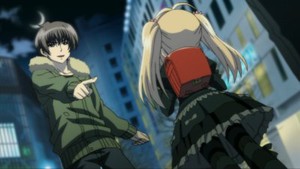
We, Without Wings – Ore-tachi ni Tsubasa wa Nai
Rating: 1 (of 5)
Review:
I've seen my share of head-scratching avant-garde anime. I've seen Cat Soup and Mind Game and Lain and things that leave lesser mortals wondering what the plot was about, or if there was a plot at all. But who'd have thought that my undoing would be a visual novel adaptation?
We, Without Wings tries to dress up the old boy-meets-harem formula with a meta-story involving "TV channels" linked in some kind of "hypothetical fairy tale." But what it really means is that, instead of following the exploits of one young lad and the ladies who love him, the first episode skips inexplicably between a whole gaggle of male characters having varied encounters with the opposite sex. In one scenario, a high-schooler finds his walk to school disrupted by all manner of bishoujo clichés; after the opening credits, ten pointless minutes are spent at a casual restaurant where a freeloader is trying to invite young waitresses to a get-together; then comes the nighttime story of a part-timer wandering the international part of town and taking on a thankless construction job because he needs the money.
Does this make sense to anyone? No? Didn't think so. This is more nonsense than Steins;Gate and Chaos;Head combined, minus the psycho-thriller atmosphere—or a slice-of-life gone horribly wrong. Because the male characters are so blandly designed, it's almost too easy to miss the fact that they are acting out different scenarios. And the girls they meet, being mindless panty-flashing ciphers, are equally forgettable. Perhaps they become more interesting as the storyline progresses, but who's going to want to stick around for a storyline as baffling as a calculus textbook mistranslated from Russian?
With lazy animation leading the way (seriously, count all the slow pans across static scenery), and boring city backgrounds providing the setting, there's absolutely nothing to look at here—even the fanservice is boring, with its predictable array of pantyshots and boob jiggles. Surely even first-time fans have better standards than this; how bad must a show be that it even fails at being mediocre?
We, Without Wings – Ore-tachi ni Tsubasa wa Nai is available streaming on Crunchyroll.

Sekai Ichi Hatsukoi – World's Greatest First Love
Rating: 3 (of 5)
Review:
Sekai Ichi Hatsukoi is the kind of series that reveals piercing truths about one's self. For example, I discovered that I'm still not really into Boys' Love, which the first episode delivers in spades with saucy man-on-man scenes. But what I am really into is manga-publishing industry intrigue, an area where this series hits the sweet spot. After all, workplace misadventures are a universal form of entertainment—and a welcome break from the endless parade of high-school this and high-school that.
Ritsu Onodera is the name of our unlikely hero, a jaded 25-year-old who is none too pleased to be switching departments from literature to shojo manga at his publishing firm. But all his preconceptions about sparkly girly comics are about to be shattered: Onodera's new boss is a tall, strapping man not much older than him, and in fact the entire staff is comprised of young males. Onodera also learns that the rapid production cycle of manga means the workplace can morph from pink-frilled cubicle farm to fetid dump and back again in record time. Still, none of this shocks Onodera as much as discovering his boss's forceful ways ... even going so far as to lock lips with him for the sake of a "reference pose."
Ironically, it's that climactic moment—the part that will send audiences squealing with delight—that ruins an otherwise convincing industry-insider drama. The kiss is a contrived piece of fan-bait that screams, "Stay tuned to Sekai Ichi Hatsukoi for more potentially sexy action!" Look, I'll stay tuned, but mostly to find out whether Onodera can survive the stresses of his new job.
Between the pastel-toned animation that chops along at a bumpy framerate, and the sweet but melodically empty soundtrack, it's clear from the production values that this series is focused more on fancy frills and triggering naughty thoughts than putting a truly stellar product on screen. The premise and characters are appealing enough, especially for those with an interest in the business—but the rules and regulations of BL stop it from reaching the greatest heights.
Sekai Ichi Hatsukoi – World's Greatest First Love is available streaming on Crunchyroll.

Sket Dance
Rating: 2.5 (of 5)
Review:
Does Shonen Jump reflect the changing mode of the Japanese economy? In the boom years it was legendary warriors saving the universe, and then sports champions and spirit-hunters in the early recession; after the turn of the century, even unmotivated schoolkids could inherit shinigami powers, and now we have ... students helping other students? Talk about reduced expectations. But if Sket Dance is a far cry from heroic sagas of the past, at least the characters are lively enough to meet the genre's standards. Their exploits, on the other hand ...
Episode 1 sets the bar low right away with bespectacled everyman Teppei Sugihara transferring into his new school. Clichés don't get much more banal than this—unless they also involve a school club trying to recruit the newcomer. That role falls to the Sket Dan (a pun on the Japanese verb for "to help"), an eccentric trio committed to assisting students in need. It's these three, with their funny nicknames and equally funny personalities, that are the heartbeat of the show: goggle-headed ringleader Bossun, hockey-stick-toting enforcer Onihime, and the laptop-carrying, Stephen-Hawking-voiced Switch. Just stick those three in a room and watch the jokes fly!
When the time comes for serious storytelling, however, this episode reverts right back to mediocrity: Teppei enlists the Sket Dan's help in a bullying situation, so they prowl about trying to solve the case, and a surprise revelation leads to the one well-animated sequence in this episode—a fight scene where Onihime lays the smack down. Overall, though, the presentation suggests nothing more than mundane school tales of "they did this and then they did this and it was kind of cool and funny."
Not that it's outright bad or anything—the slick character designs and solid color palette are good enough. The animation, which shoulders the not-terribly-challenging burden of depicting everyday school life, is good enough. Even the mainstream rock soundtrack that punctuates moments of action is good enough. But in a medium that's supposed to take us on wild flights of imagination, is "good enough" really ... good enough?
Sket Dance is available streaming on Crunchyroll.
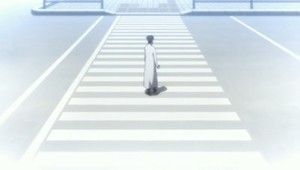
Steins;Gate
Rating: 3.5 (of 5)
Review:
Anime adaptations of visual novels would probably get a better rap if more of them were like Steins;Gate, a psychological thriller from the same studio that gave us Chaos;Head a few years back. Although both series are mind-benders designed to mess with one's perception of reality, Steins;Gate goes one further, invoking ideas of time travel and even name-dropping famed Internet weirdo John Titor. Are you ready to have your mind messed with? Then let's go.
Steins;Gate centers around Rintarou Okabe (alias Ryouma Hououin), a self-declared mad scientist who runs the so-called Laboratory of Future Gadgets (but is really just a cozy geek hangout). Okabe's adventure begins when he visits Akihabara to hear a lecture from a supposed time-machine inventor. After Okabe ditches the lecture, however, strange things start to happen: he discovers a fellow researcher's bloody corpse while exploring the halls, city crowds briefly disappear while he's crossing the street, and a satellite crashes into the building that he was just in. But when Okabe tries to discuss these events with others, their conflicting accounts begin to puzzle him. Only after comparing text messages does he realize: did he just experience some kind of time-slip?
This premise borrows plenty from its science-fiction forebears, but Episode 1 still mixes things up enough to be a brain-tickling delight. The deceptive storytelling creates a neat little guessing game of imagination versus reality and past versus present (or future?), while the characters' odd personalities give them an intriguing, dark-edged quality. That edge is also bolstered visually by a shadowy color palette, striking camera angles, and animation that's polished enough to present the "normal world" and then subtly start adding abnormalities to it. The sparse, dissonant background music also reinforces this unsettling mood.
It would be nice, though, if Okabe stopped ranting and raving about "the Organization" (an actual cabal of stereotypical cackling villains, or just a spoof thereof?), and if the episode hadn't wasted so much time on the Future Gadget club's day-to-day activities. But as a suspense-filled head trip, this one definitely has promise.
Steins;Gate is available streaming on Crunchyroll.
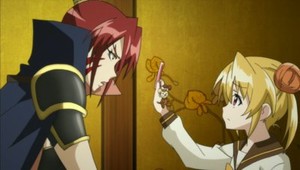
Battle Girls – Time Paradox
Rating: 2 (of 5)
Review:
Clearly, one thing that the newly ratified Tokyo Youth Ordinance Bill has not yet eliminated is impractical, suggestive medieval armor. I guess no one ever screams "Think of the children! Moral panic!" when some huntress garbed in bikini-mail comes crashing through the woods with her longsword. Then again, this series commits far worse transgressions than just violence and improper combat attire—it sets a bad example with its lazy storytelling and shameless genre exploitation. Even worse, it tries to cover it up with loud, effects-laden fight scenes.
Similar in plot to the reprehensible Dog Days, Battle Girls offers another variation on the ordinary-student-sucked-into-historical-adventure formula, except with an all-female cast and a feudal Japanese setting. Meatball-headed schoolgirl Hideyoshi is constantly late for school, always failing tests, and so clumsy that one day she stumbles into a mystical ritual and ends up several centuries in the past. Enter bosomy warrior Oda Nobunaga and her equally shapely aide Akechi Mitsuhide, who rescue Hideyoshi from certain death and try to figure out what to do with her. A predictable culture-shock routine follows, with the warriors gawking over this tool of witchcraft called a "cell phone," while Hideyoshi wonders where all the modern amenities like flush toilets and train stations are. In other words, this series manages to go double-cliché by genderbending Japanese history (last year's Samurai Girls got there sooner) and then chucking a kid from the modern era into it.
Between the characters, the premise, and the feeble attempts at humor, every aspect of this first episode is so crusty and worn-out that it might spontaneously crumble to tatters if you stare at it too long. The barely-serviceable animation doesn't help either, with most of the effort going into accurately rendering Nobunaga's breasts and juicing up battle scenes with as much fire, explosions, and glowing magical effects as possible. Then again, wise viewers should have known to bail out right from the bland, tuneless opening theme.
Maybe it's time to author a bill against embarrassing representations of history.
Battle Girls – Time Paradox is available streaming on Crunchyroll.

Dog Days
Rating: 1 (of 5)
Review:
Who enjoys being bored out of their minds while sitting through predictable genre slop? Great, then here's the first big clunker of the season! Dog Days takes one of the most wretched plot devices in all of fantasy—the everyday schoolkid who is transported to a medieval world and becomes a destined hero—and plops animal ears and a tail on it. Literally.
The hilariously-named Republic of Biscotti faces a national crisis: it's being invaded by warriors who look like they just got back from their local convention. But in a bizarre fantasy world where everyone has a pair of mammalian ears and a bushy tail, furry-fetish prosthetics are clearly not as much of an issue as national defense. The Biscotti Republic's princess decides that the time has come to summon a hero, and as luck would have it, some British kid living in Japan (don't even ask why; they never explain) named Shinku has been fated to fall down a hastily CGI-ed magical wormhole. When he pops out the other end, Shinku is informed that he is Biscotti's hero of destiny—which he refuses to believe for about 5-7 minutes, in order to drag out the episode—but then has a change of heart right before the end so that we can segue into the closing credits with a dramatic pose.
It's hard to think of a more unimaginative piece of junk than this, which moves mechanically from one plot point to the next and doesn't even try to add fresh ideas or unexpected twists to the premise. In fact, nothing illustrates the show's creative bankruptcy quite like the rip-off chocobos that were apparently borrowed from the Final Fantasy universe. And the main character designs are hardly worth mentioning either: the protagonist is yet another spiky-haired teen (albeit blond instead of black this time), and the princess and her warriors look like escapees from a How to Draw Japanese RPG Characters manual. All of this, set to a tinkly "let's pretend these synths are trumpets" soundtrack, makes for an utterly putrid, soul-crushing fantasy failure.
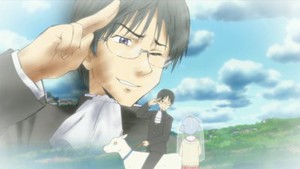
My Ordinary Life
Rating: 3 (of 5)
Review:
No other anime this season is more likely to leave audiences scrunching up their faces and going "WHAT?!" than My Ordinary Life.
Whether that reaction is one of amusement or disgust, however, is another question entirely.
Following in the proud tradition of cute girls doing cute things, this light gag comedy begins with students Yukko (the talkative one) and Mio (the spacey one) discussing ... some pointless aspect of their lives. At the same time, a wind-up robot girl who lives at home with her creator experiences an earth-shattering crisis when a cat makes off with the fish she was grilling in the backyard. Yes, it really does become earth-shattering when the she chases after the cat, bumps into a passer-by, and triggers an Akira-esque neighborhood explosion ... that catches Yukko and Mio in the blast.
It's this kind of mind-boggling punchline that is My Ordinary Life's stock-in-trade, which works either to its advantage or its detriment, depending on who you ask. To the show's credit, the animators are clearly putting in the work; a later scene involving a wayward morsel of food turns into an all-out, heart-stopping visual barrage worthy of any shonen action blockbuster. Other times, the animation style is less spectacular but still full of personality, with shifts in style and quirky angles that keep the scenes from getting stale (always the greatest danger of a slice-of-life series). Heck, even the background music defies expectations, with a lightly jazz-influenced level of sophistication—listen for it during moments like the fire alarm gag. Come on, how are we supposed to rag on high school sketch comedies being cheap and lazy when the production team actually puts effort into it?
Still, waiting for those punchlines can feel like a chore, and the disconnected storytelling is difficult to follow if one does not pick up on the characters right away. (Robot girl? Kid on a goat? Who of the what now?) But those who have the patience for everday schoolgirl antics—always a polarizing issue—will be rewarded for sticking around.
My Ordinary Life is available streaming on Crunchyroll.

Hanasaku Iroha
Rating: 4 (of 5)
Review:
Hanasaku Iroha is the ninja anime that has nothing to do with ninjas. It sneaks up on you from behind, waits until you've sensed its presence, then sweeps your leg and knocks you to the ground. That's what's so ninja about it—the way it defies expectations with subtle turns of plot and an air of elegance.
The story centers around Ohana Matsumae, a 16-year-old on the fast track to boredom with her humdrum city life. But when her single mother decides to elope on a whim (even announcing the news over dinner as if it were the most natural thing), Ohana suddenly sees the realms of possibility open up. She moves out to her grandmother's traditional small-town inn looking for a fresh start, but Ohana's dreams of a heartwarming coming-of-age experience are diverted when she learns that her grandma disowned her mother, meaning that Ohana will be expected to earn her keep by working at the inn under a strict code of discipline.
Oh, and one of the other girls working at the inn hates her already.
What makes Hanasaku Iroha work so well from the outset is the way it tweaks all the usual teenage clichés—parental figures actually declare their intention to leave instead of being assumed nonexistent; the heroine takes matters into her own hands instead of being forced to move; even a standard confession of love comes with its own particular charm. And the characters themselves, with their carefully animated expressions and gestures, feel like genuine people with thoughts and feelings, not the stock anime stereotypes that show up all too often.
Even the scenery seems to have a life of its own—the sunset reflecting off steel and glass in the city when Ohana contemplates her predictable future, the picturesque greens and blues as she takes the train ride out to escape that future, and the views from the grounds of the inn itself, reminding us that there are still oases of nature-filled beauty in the modern world.
And as this thoughtful episode points out, sometimes poison water lurks at the bottom of the oasis.
Hanasaku Iroha is available streaming on Crunchyroll.
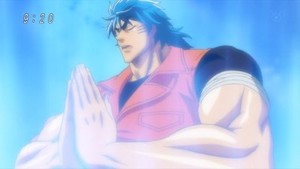
Tiger & Bunny
Rating: 3.5 (of 5)
Review:
Hey, Tiger & Bunny, what're you trying to say here? Superheroes, reality shows, corporate sponsors, product placement, and economic downturns?
If you needed any further confirmation that Japanese anime studios are scoping out potential foreign audiences when they greenlight a new show, this is it. The series has "Region 1 license" written all over it, with a dizzying American pop-culture pastiche designed to amuse fans on either side of the Pacific. The story begins in Stern Bild, an ultra-modern city where DC/Marvel-type superheroes are a fact of life—except that they have corporate logos plastered across their skintight suits and have their exploits shown on TV as if it were a professional sport. That wry premise alone ought to sell the series.
Yet the spoofing doesn't stop there. Each character maps to a particular superhero stereotype, and Episode 1 directs our attention to Wild Tiger, a blue-suited veteran whose freewheeling, collateral-damage-causing habits have worn out the goodwill of his sponsors. When his job is reshuffled after a company buyout, Tiger figures it's time to look for a new line of work ... until he discovers the new management has decided to make him a sidekick to the babyfaced newcomer who will inherit Tiger's powers. Talk about a sharp-witted, socially relevant slap in the face.
Where this episode trips up is in trying to wow the audience with a nonstop, 10-minute action sequence to start the show—when in fact the premise is already understood within the first two minutes and the rest is just over-the-top madness that leaves you wondering when the real story is going to start.
Slick production values, bright colors and unique character designs (with faces made to look distinctively Western) will keep eyes glued to the screen for this series, although the CGI looks a bit forced and perhaps calls too much attention to how much is being spent on the animation budget. Rousing battle music also adds heft to the action scenes, promising a superhero adventure that's as intense as it is clever.
Tiger & Bunny is available streaming at Hulu, VizMedia.com and here on ANN.
discuss this in the forum (700 posts) |
this article has been modified since it was originally posted; see change history
back to The Spring 2011 Anime Preview Guide
Season Preview Guide homepage / archives